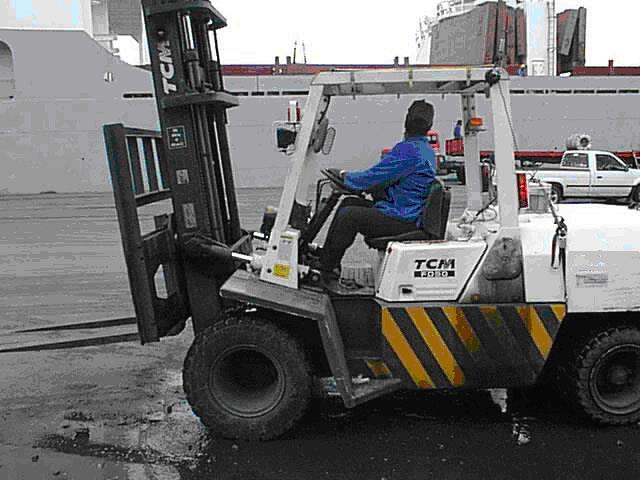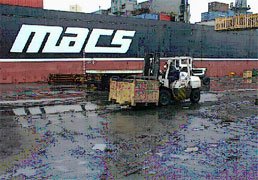 Forklift driver in South Africa/ photo by Darren Joubert |
The UK Health & Safety Executive estimates more than five million working days are lost in the UK each year due to back pain. Vibrations transmitted to the body from off-road vehicles have been singled out as a cause of back pain. Off-road vehicle seat manufacturer Grammer AG's research found more than 7.5 million workers in Europe were subjected to whole-body vibrations. It is not surprising then that the European Union (EU) is leading the world with its "vibration directive".
Christine Liew reports.
In 2002, EU member states agreed to adopt Directive 2002/44/EC, the physical agents (vibration) directive, to set minimum requirements for the health and safety of workers exposed to vibration. The directive was incorporated into member states' national legislation this year. Between now and July 6, 2010, there is a transitional period in which equipment supplied before July 6, 2007, is allowed to exceed the vibration exposure limit. EU countries must deliver a report to the European Parliament and the Council of the European Union, listing general exceptions in the first stage of implementation by the end of 2006. The EU will examine progress of the directive's implementation in member states. After the transitional period, there will be no further exceptions. Agricultural and forestry equipment are exempted from the 2010 deadline and have until 2014 to comply.
The vibration directive introduces "daily exposure action value" and "daily exposure limit value" into the vernacular of occupational health & safety agencies. Both values are standardised to an eight-hour reference period. The exposure action value is 0.5 m/s². It serves as a warning. If the value is exceeded, alternative work methods, worker information and training, and the use of ergonomic work tools are possible "actions" to take to avoid vibration exposure.
With the daily exposure limit value, a worker must stop work immediately if the value is exceeded. The daily exposure limit value is 1.15m/s² but may be set lower by individual countries.
Darren Joubert, lecturer in occupational health & safety at Western Australia's Curtin University of Technology, has researched whole-body vibration (WBV) exposure in forklift drivers and published several papers on the topic.
Joubert said there were no legally-binding standards on vibration exposure in Australia, North America or Asia.
"The new exposure standards and action limits in the EU are a major breakthrough."
He said there was a need to protect forklift operators from WBV and attributed the lack of protection in non-EU countries to ignorance.
"It is a hazard that is not nearly as well known or acknowledged as other more visible hazards, like safety hazards, noise and chemical exposures, yet it has detrimental and long-term effects."
Vibrations happen when a body moves back and forth because of external or internal forces. There are two types of occupational vibration. Hand-arm vibration, which is usually a consequence of using hand-held tools, and WBV, where vibration is transmitted to a forklift operator's body through the forklift's seat or platform. According to the EU's Good Practice Guide for WBV, medical studies of long-term WBV exposure have found evidence of elevated health risks, mainly in the lumbar spine, but also in the neck and shoulders.
The guide was produced by health and safety representatives from three EU member states for the European Commission Directorate General Employment, Social Affairs and Equal Opportunity.
"In some cases an increased prevalence of gastro-intestinal complaints, peptic ulcers and gastritis has been reported in drivers of vibrating vehicles. WBV seems to be a factor that, in combination with the long-term sitting posture of drivers, contributes to the occurrence of varicose veins and haemorrhoids. Some studies have reported evidence of effects on the digestive system, the female reproductive organs and the peripheral veins," the guide said.
Joubert said a study he conducted in South Africa found 89 per cent of forklift drivers complained about lower back pain.
"The cause is vibration exposure, sitting for long periods, and twisting and other awkward body positioning when manoeuvring loads into place. Other factors include lack of exercise and, in many cases, a high body mass index."
 Another forklift driver in South Africa/ photo by Darren Joubert |
In February 2005, Joubert told
Forkliftaction.com News he was researching a possible link between erectile dysfunction and WBV exposure. During his study of South African forklift drivers and lower back pain, he surveyed 209 drivers who used diesel engine forklifts at the Port of Durban. He said many complained of erection difficulties (
Forkliftaction.com News #195).
No specific studies had been conducted on erectile dysfunction as an adverse reproductive outcome of WBV. That, in addition to the anecdotal evidence gathered in South Africa, prompted Joubert's interest in doing a study. Unfortunately, the research has been put on hold. Joubert said a lack of understanding and recognition of WBV in Australia made it hard for him to secure research funding. He is currently researching heat stress in occupational settings.
The EU vibration directive requires employers to conduct risk analyses at workplaces to assess how long workers can use forklifts before reaching the exposure action value. The UK Health & Safety Executive (HSE) advises in its
Control back-pain risks from WBV leaflet that most employers of drivers or forklift operators could conduct broad risk assessments without having to do measurements or employ vibration specialists.
The HSE advises employers to collect basic information by observing work tasks and talking to managers and employees. Simple control measures could be introduced after assessing the risk. Exposure to vibration may be high if a vehicle manufacturer's handbook includes a warning of WBV risk, forklift drivers use poor techniques, like driving too fast, work areas are potholed or cracked, or if forklift drivers are continuously shaken and, when going over bumps, rise visibly in the seat.
"Most machine and vehicle activities in normal use will produce daily exposures below the limit value but some off-road machinery operated for long periods in conditions that generate high levels of vibration may exceed the limit," the leaflet said. HSE advised it was more effective for employers to expend resources controlling risks than trying to assess the precise vibration exposure values.
When risk assessments conducted by employers indicate workers are at risk of vibration injury, the vibration directive requires employers to ensure workers undergo health surveillance. That is particularly for workers whose daily vibration exposure exceeds the daily exposure action value. Health records are kept up to date for workers and supplied to health professionals. A doctor or occupational health care professional will inform the worker and the employer of any adverse health effect regarded as an effect of WBV exposure. Employers then take action by reviewing risk assessments and implementing measures to reduce WBV exposure. A worker may be assigned to alternative work.
Several websites include vibration emission data for certain makes and models of machinery. On German website
www.las-bb.de/karla/index_.htm, about 360 forklift models' WBV exposure values are listed. However, while such data is a helpful indication of a machine operator's vibration exposure, it cannot be used exclusively. Vibration exposure depends on individual workplace conditions, like driving surfaces, equipment maintenance levels and operator techniques.
German forklift manufacturer Jungheinrich AG spokesperson Sebastian Riedmaier said employers had asked "how long can employees operate forklifts before they reach the exposure action value?" He said there was no standard answer as each individual workplace had to be assessed by risk analysts.
"A research project supported by German forklift manufacturers plans to identify 'critical' and 'non-critical' workplaces, according to descriptions of forklifts' work conditions, like floor, obstacles and travel distance.
"The current state of research is that often measurement on-location is necessary and indispensable, especially for forklifts working outdoors."
Riedmaier said Jungheinrich and other forklift manufacturers planned to offer a service to measure vibrations at workplaces.
The forklift manufacturers could compete with vibration specialist companies like Netherlands-based Beizein. They would also provide advice on how to reduce vibration exposure.
Beizein of Emmeloord, the Netherlands, recently measured the vibration values of 19 forklifts from five manufacturers, Still, OM Pimespo, Yale, Jungheinrich and TCM. The same drivers drove forklifts with and without 800kg loads indoors on an asphalt road and outdoors on cobble stones. The forklifts' tyres ranged from solid to pneumatic, and the forklift seats came from different manufacturers.
 Dirk Zeinstra |
Dirk Zeinstra, a vibration specialist with Beizein, concluded vibration and shock depended on a driver's driving style, the driving route and road surface, the sitting height on the forklift, the type of tyres and the type of seat. All the forklifts' WBV exposure values were found to be above the EU action value of 0.5 m/s².
"A relaxed driving style had the best benefit in reducing shocks and vibrations," he said.
While forklift ergonomics is one of several contributing factors to WBV, forklift manufacturers in Europe are aware of the EU regulations and consider the effects of vibration when designing forklifts. The EU machinery directive (Directive 98/37/EC), which defines health and safety requirements for machinery supplied in the EU, includes specific guidelines for vibration. The directive requires machine manufacturers, importers and suppliers to include information on risks from vibration, and WBV emission data for mobile machinery, in instructions accompanying the machine.
Matthew Henry, publishing director of Kingsdown Marketing, speaking on behalf of Swedish forklift manufacturer BT, said all new BT models were measured for vibration, with the results published in the forklift operators' manual.
"EU regulations do not make truck manufacturers responsible for vibration experienced once a truck is in use, but BT has always considered the effects of vibration as part of its wider approach in improving drivers' experiences, with consequent benefits to productivity," he said.
"Most BT trucks, such as reach trucks, are powered by electric motors, on which vibration is not a significant issue. BT counterbalance trucks, powered by internal combustion engines, are subject to greater levels of vibration."
Henry said counterbalance trucks were designed from the "ground up" to minimise the spread of vibration from the drive train through to the driver compartment.
Jungheinrich AG's forklift designers have developed a "floating cab", which they say provides "double protection" for drivers. Vibration impact on drivers is reduced because the cab module, instead of being rigidly screwed onto the frame, is positioned on damping elements that absorb impact otherwise directed towards the cab.
Since CeMAT 2005, all Jungheinrich's counterbalanced forklifts have been fitted with MSG 65 Grammer seats, which are highly cushioned. Operators can adjust the seat suspension to their weight by raising or pressing a control lever.
Korean manufacturer Doosan Infracore's European operations are also aware of EU regulations.
"As a manufacturer of forklifts we have always been concerned about vibration and have published vibration values in our operation manuals since we started in Europe as Daewoo," Doosan Infracore Europe SA product support manager Patrick Goosens said.
Doosan Infracore's tests had shown its forklifts produced vibration values "well below the limits of Directive 2002/44/EC" but the manufacturer was continually working to reduce the values further through "conscious engineering and material choice of drive train mountings, seats, levers and choice of engine.
"In the end, even though forklift manufacturers are obliged to produce the best possible product, major contributors to vibration are operator technique, surface conditions and equipment maintenance levels," Goosens said.